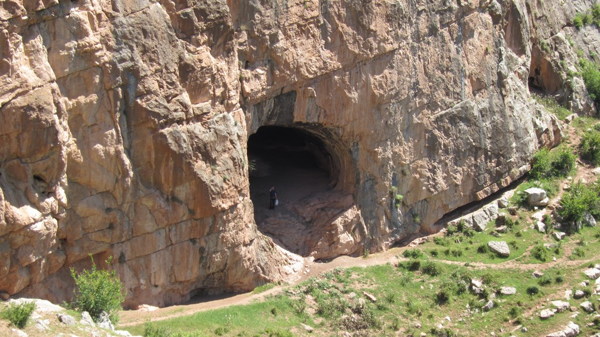Iran’s Cultural Heritage, Handcrafts and Tourism Organization in September 2014 issued a leaflet on Darband Caves, which have been home to humans as far back in history as more than 200,000 years ago. What comes below is the translation of the information the leaflet provides on this ancient natural site:
Some 230,000 years ago, concurrent with a warm interglacial period, Darband Rashi Caves were a safe haven for humans who used them as makeshift shelters. What is left behind by the ancient hunters offers the oldest evidence [the age of which can be determined by modern-day dating methodologies in archeology] about the early inhabitants of Iran.
Darband Rashi Caves are to the south of Rashi village, nestled, at an altitude of 750 meters, between Rahmatabad and Blukat villages of Rudbar, in the northern Iranian Province of Gilan. Mount Dorfak, which is also known as Dolfak [nest of eagle], with the elevation of 2,720 meters is located in this region too.
On the southern flank of the slope leading to the mountain, there are deep, narrow valleys which channel the water coming from the mountain springs to the Siah-Rud River from the eastern tributaries of the river. Darband Rashi Caves are located on the northern side of one of these valleys and their walls are all but vertical.
The archeological site has two major caves. The larger one is as long as 60 meters and the other one is 30 meters in length. Both caves face south. Also, both caves have sedimentary floors, which are in some parts composed of Travertine [a limestone deposited by mineral springs]. The floor composition indicates that water and humidity have penetrated the cave.
The shorter cave was first explored and studied by archeologists with Iran’s Cultural Heritage, Handcrafts and Tourism Organization in 2005. Further examination of the cave produced a collection of animal and human remains, and a number of earthenware items which date back to the first millennium B.C.
Excavations of the nearby cave uncovered a number of terracotta objects which were as old as the items unearthed in the first cave. After preliminary examinations, applications to have the caves registered as a national site were prepared and in August 2005 they were registered as a national heritage site. On further examination, some animal fossil remains such as those of cave bears as well as stone artifacts including a cleaver and a carved chip were discovered.
In April 2012, a team of archeologists headed by Dr. Fereydoun Biglari from the National Museum of Iran with the help of Dr. Vali Jahani, the head of Gilan’s Archeological Research Center, along with an interdisciplinary team of experts carried out more detailed research to dig out more information about the Median culture of cave inhabitants during the Paleolithic Era, their exploitation of ecology and resources in the vicinity of the cave, the regional vegetation and climatic conditions and the way such caves and their ancient sediments tool shape throughout history.
Such examination and speculation resulted in a rich collection of animal fossils and stone artifacts crafted by the cave inhabitants which helped archeologists get a better insight into one of the most unknown and ancient prehistoric periods of Iran.
Preliminary studies of the fossils indicated that the now-extinct cave bears, as well as deer, bulls, and wild goats used to live there. In addition, a number of tools belonging to the Paleolithic Era, including an ax and some other objects were among the archeological finds.
Further studies can shed light on the way such tools were crafted out of parent material by cavemen. Besides, examination of geological composition in the region can help experts find out what stones were used in crafting such tools and consequently develop an understanding about the geological changes of Darband Valley throughout history. A sample containing a few animal teeth was collected from a layer to have the age of them determined through uranium dating. The results can play an important role in specifying the exact date when humans started dwelling in these caves.
Preliminary dating has indicated a hunter-gatherer society used these caves in the mid Pleistocene era (about 200,000 years ago). Darband Caves offer the most ancient evidence, dated by modern, definite methods, about human habitation in Iran.
On the whole, the properties of stone tools and animal remains as well as their age suggest that Darband Caves served as a makeshift shelter to hunter-gatherers toward the end of the Paleolithic Era.
Darband Caves were probably a place where one of the subspecies of cave bear hibernated; their remains in the caves presented the first evidence about the existence of such animals during the Quaternary Period.
Initial studies into the archaeological finds discovered in the caves suggest that this site can clear up a lot of confusion about the cultures of the Paleolithic Era and the environment of the early communities who lived to the west of the Alborz Mountains, and Iran at large.
Darband Caves, the only known caves with archeological finds belonging to the Paleolithic Era in Iran, offer us a unique opportunity to add new chapters to the history book of human habitation in Iran. More in-depth archeological and interdisciplinary studies into Darband Caves, their preservation and introduction as the earliest recorded human habitation in Iran are some of the most important goals that Iran’s Cultural Heritage Organization hopes to fulfill in the not-too-distant future.
